
The methods and techniques of weaving are determined by the shape and purpose of the product, the material from which it is made. Weaving is thick (continuous), rare (openwork). By types it is divided into simple, layered, in rows, square, openwork, rope, bending, etc.
For continuous, simple and layer-by-layer weaving is used most often, less often in rows and square. In the manufacture of one product using several types of weaving: solid and openwork, both in combination, with a string and a bend.
Simple weaving - single rods are woven through one rack in the form of a continuous ribbon, layering one row over another along a gentle spiral. For continuous weaving, there must be an odd number of racks, since for even there will be no interlacing.
Weaving begins with butt rod, laying it on one side, then on the other side of the uprights. In closed shapes, layering is circular in one direction - from left to right; in the open order, the order is somewhat different: when one row is completed, around the extreme stand they make a turn, go around it and spin it in the opposite direction (Fig. 1, b).
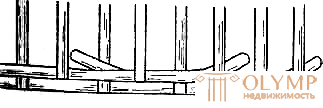 | 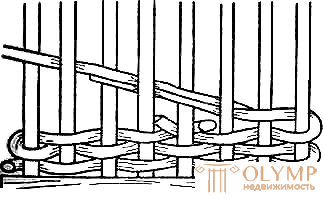 |
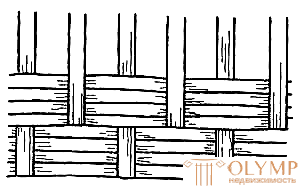 | 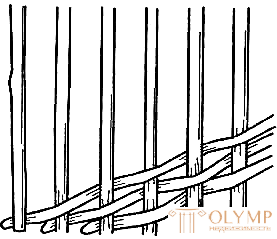 |
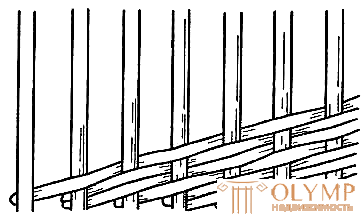 |  |
 | Fig. 1. Methods and weaving technique |
If the rod ends with the apical part, the new one is attached to it also with the vershinka, while for greater strength the next rod for three or four racks is woven next to the previous one (Fig. 1, a).
When the rod ends with a thick butt end, the next rod is also supported by the butt part in the direction where the previous one ends, and the weaving is continued. All the ends of the twisted rod are turned to the inner, opposite side. Periodically weaving is leveled and compacted with light blows of the isera. It is necessary to constantly monitor the location of the racks so that they are located at an equal distance from each other and do not go to the side.
Simple weaving is often performed with double and triple rods (Fig. 1, c). A variety of simple weaving is weaving ordinary, double or more rods with weaving them to the risers at an angle of 45 ° or more (Fig. 1, g-g).
Layer-by-layer weaving (Fig. 2) - through a single rack with several rods. In this case rods of the same length and thickness are required. Begin weaving with the butt end of the rod, weave four pillars and leave the end on the outside. Do not press the rod; It should be slightly raised. Starting weaving each next rod from the new rack on the left side, successively weaving four racks to the right, they reach the first, initial rack.
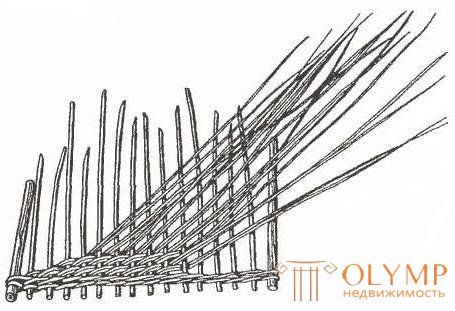 | 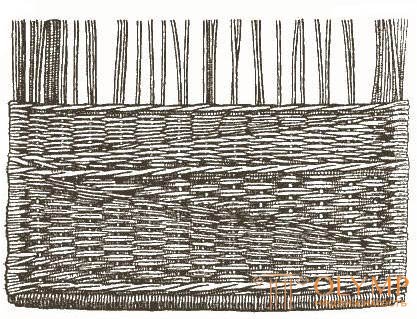 |
| Fig. 2. Layered weaving | Fig. 3. Weaving in rows |
All ends of the rods should be on the outside. Then they begin to weave from left to right, successively weaving one rack after another until the circle is closed and all the rods are braided.
Further, the second layer is woven in a similar way, then the third and the next, until the end of the weave. Starting and finishing weaving, the ends of all the rods are left inside the product.
Weaving in rows (Fig. 3). Perform as follows: butt of the first rod lay under the rack and weave through one rack until it ends; the second rod is laid under the next rack and weave in the same way as the first; Further, starting from the third pillar, weave a third rod. Such weaving is continued until a row is completely woven; then weave the second row, and if necessary, the third. You can weave one or two rods. The layering of the thin ends of the rods into thick ones gives a clear diagonal line due to the difference in their thickness, the result is a beautiful band that spirals envelopes the product.
If, when weaving, the rod butt is laid under the stands from right to left, then the diagonal goes in this direction, and, conversely, when the rod is laid to the right, the diagonal is obtained from left to right.
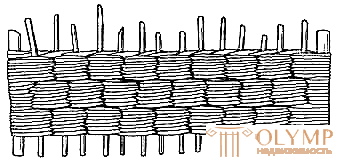 | 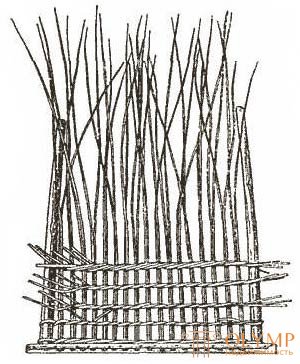 |
| Fig. 4. Square weaving | Fig. 5. Weaving rope |
Square weaving (Fig. 4). It is started at the butt end of the rod and is led from left to right through two pillars (counting and angular) until 5-10 cm remains on the outer end of the rod on the outer side. two racks, bring its ends out on two racks further. Similarly, weave the following rods until a square is obtained, that is, the height of the interwoven row will be equal to the distance between the two racks.
Having finished weaving the first row of squares, weave the second, but begin to weave from the next stand and with the vertex ends of the rods. Similarly, weave the following rows of squares to the desired height. Special attention should be paid to the weave compaction in the place where the rod bends around the stands.
Weaving with a rope (Fig. 5) is used to strengthen the upper and lower ends of the side walls and the bottom bases of the bottom, to join and fasten individual elements during openwork weaving. Weaving rope is that the rods not only braid racks, but also intertwined, tightly covering the rack.
The following types of weaving are distinguished: a rope in two, three, four and five rods.
A rope in two rods is a weave in which two rods are woven simultaneously: the first one is put in one of the uprights, the second out from under it for the next upright and the third stand is woven, and so on. and the fourth pillars, and the end of the second - between the fourth and fifth pillars, with the first rod should be below, and the second from the top.
A three-twig rope is weaved simultaneously with three rods. The first rod is laid behind one of the uprights, the next second and third rounds go around the outside, and the fourth from the inside and out. The second rod is laid between the second and the third pillars under the first rod, two are twisted outside from the outside, and from the inside, one stoic is brought outside into the gap between the fifth and sixth stands.
The third rod lay in the gap between the third and fourth racks and output the end between the sixth and seventh racks. Then the weaving is continued: each rod is successively bending around one inside and two pillars outside.
A rope of four rods is weaved simultaneously with four single rods. Each of them successively bend around two racks, either from one side to the other. When rounding the bars intertwined, the result is a double-sided string. A rope of five rods is weaved at the same time by five single rods. Each of them consistently bends around one rack from the inside, and four from the outside. Before weaving the rope for its thickening and fastening the outside along the racks stack rod, which is braided together with the racks.
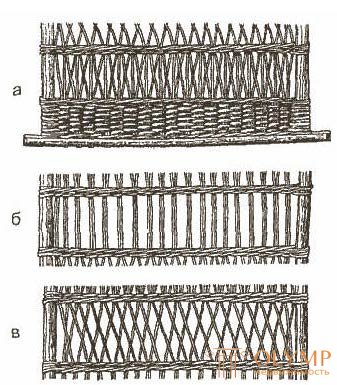 | 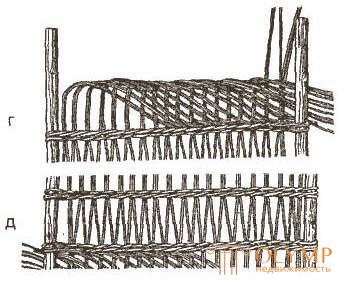 |
| Fig. 6. Samples of simple openwork weaving: a - an asterisk, b - a column, in - a diamond, d - a finishing in two rods, d - a half-homb (wedge) | |
Openwork weaving (Fig. 6) - with open cells. Types of openwork weaving are very diverse. It is simple and complex (Fig. 7). A complex openwork can reproduce drawings of lace, fabrics and various shapes. Most often openwork is used in combination with other types of weaving. Openwork weaving gives the product a decorative, elegance of form and pattern.
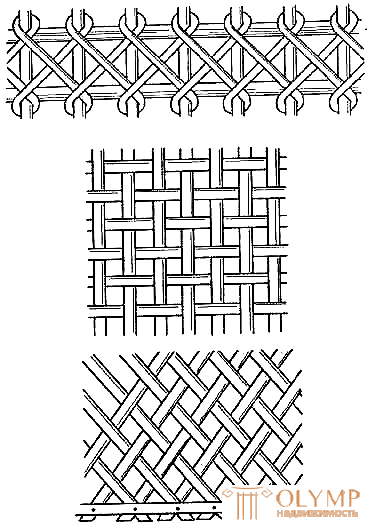 | 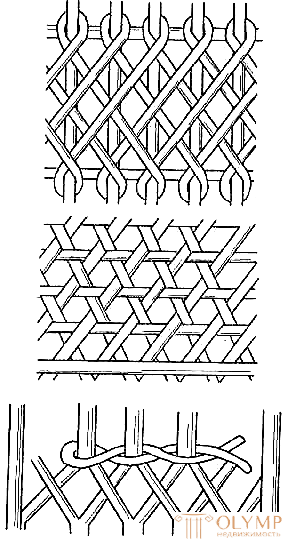 |
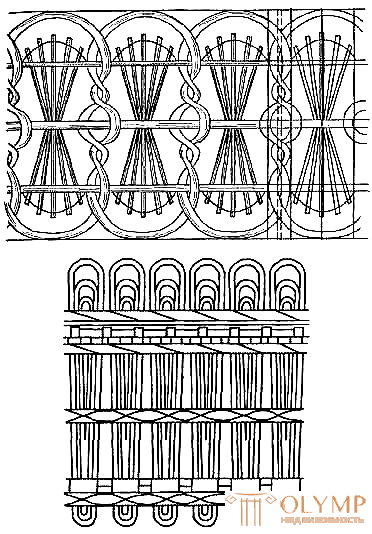 | Fig. 7. Samples of openwork weaving |
Weave bending oblique. There are two such weaving - overhead and edging braids. They usually complete weaving walls. Laid on braids weave separately from three, four or five pairs of rods by simple weaving them with subsequent fastening to the edges of the product.
Edged pigtails start from the ends of the uprights from left to right (Fig. 8, a). Take one of the racks and, putting under it an awl or a piece of twig, bend out. Similarly, bend the second rack (Fig. 8, b). The first rack with an awl is carried out under the second one and, after bending around the next stand, is brought inside (Fig. 8, c).
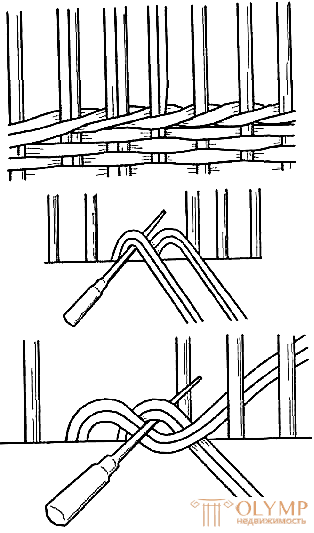 | 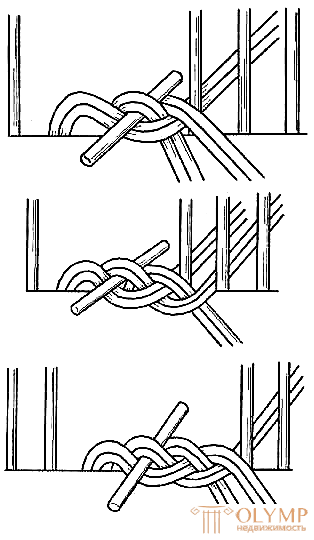 |
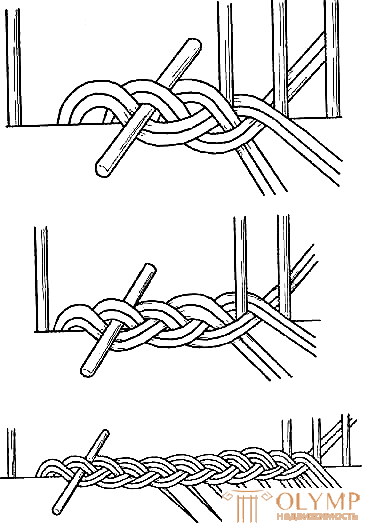 |
Fig. 8. Weave bending oblique |
In this place, removing the awl, leave the wedge and mark the beginning of the weaving of the bend. The third rack is bent under the first and left outside, and the second under the third and left inside (Fig. 8, d, e). Then by the first pillar round the fourth one and go outside (fig. 8, f, g), while receiving the first three rods. The second pillar bends around the fifth pillar, goes outside and gets the second three rods (Fig. 8, h). In the same way receive the third three rods.
Of the three rods bent together, the outermost one is left on the right side, and the other two rods pass in a similar way under the rods bent by the second three and the next bar and go outside (Fig. 8, and).
So do the following threes twigs, leaving all the time the extreme rod on the right side. Having reached the end of the weaving, the remaining ends of three pairs of twigs are hidden in a braid, and the rest are exactly cut off (fig. 8, k, l)
Что бы оставить комментарий войдите
Комментарии (0)